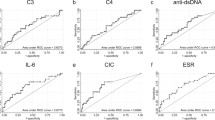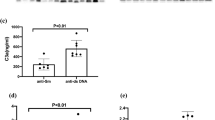Abstract
Activation of the complement system plays a fundamental role in the pathogenesis of systemic lupus erythematosus (SLE). For the past several decades, quantifying this process has focused primarily on determination of serum C3 and C4, although the utility of these assays for diagnosis and monitoring disease activity is still debated. During this same timespan, knowledge of the complement system has exploded, with identification of more than 30 proteins, an abundance of newly recognized functions, and even a third pathway of activation. These advances suggest that it is appropriate to revisit the complement system as a potential source of biomarkers for SLE. This paper reviews briefly the role of complement in SLE and other inflammatory diseases, discusses conventional methods for complement measurement and their drawbacks, and focuses on recent advancements in harnessing the complement system for monitoring SLE. Specifically, novel assays that measure cell-bound complement activation products are introduced and their utility as biomarkers of SLE disease activity is discussed.
Similar content being viewed by others
References and Recommended Reading
Walport MJ: Complement. First of two parts. N Engl J Med 2001, 344:1058- 1066.
Walport MJ: Complement. Second of two parts. N Engl J Med 2001, 344:1140- 1144.
Jongen PJH, Doesburg WH, Ibrahim-Stappers JLM, et al.: Cerebrospinal fluid C3 and C4 indexes in immunological disorders of the central nervous system. Acta Neurol Scand 2000, 101:116- 121.
Sturfelt G, Sjoholm AG: Complement components, complement activation, and acute phase response in systemic lupus erythematosus. Int Arch Allerg Appl Immunol 1984, 75:75- 83.
Gabay C, Kushner I: Acute-phase proteins and other systemic responses to inflammation. N Engl J Med 1999, 340:448- 454.
Manderson AP, Botto M, Walport ML: The role of complement in the development of systemic lupus erythematosus. Ann Rev Immunol 2004, 431-456. An extensive review of the intricate roles of the complement system in the protection against and development of SLE.
Liu C-C, Ahearn JM, Manzi S: Complement as a source of biomarkers in systemic lupus erythematosus: past, present, and future. Curr Rheumatol Reports 2004, 6:85- 88.
Valentijn RM, van Overhagen H, Hazevoet HM, et al.: The value of complement and immune complex determinations in monitoring disease activity in patients with systemic lupus erythematosus. Arthritis Rheum 1985, 28:904- 913.
Falk RJ, Agustin MD, Dalmasso P, et al.: Radioimmunoassay of the attack complex of complement in serum from patients with systemic lupus erythematosus. N Engl J Med 1985, 312:1594- 1599.
Abrass CK, Nies KM, Louie JS, et al.: Correlation and predictive accuracy of circulating immune complexes with disease activity in patients with systemic lupus erythematosus. Arthritis Rheum 1980, 23:273- 282.
Morrow WJW, Isenberg DA, Todd-Porkropek A, et al.: Useful laboratory measurements in the management of systemic lupus erythematosus. Quart J Med 1982, 202:125- 138.
Esdaile JM, Abrahamowicz M, Joseph L, et al.: Laboratory tests as predictors of disease exacerbations in systemic lupus erythematosus: why some tests fail. Arthritis Rheum 1996, 39:370- 378.
Esdaile JM, Joseph L, Abrahamowicz M, et al.: Routine immunologic tests in systemic lupus erythematosus: is there a need for more studies? J Rheumatol 1996, 23:1891- 1896.
Ratnoff WD: Inherited deficiencies of complement in rheumatic diseases. Rheum Dis Clin North Am 1996, 22:75- 94.
Barilla-LaBarca ML, Atkinson JP: Rheumatic syndromes associated with complement deficiency. Curr Opin Rheumatol 2003, 15:55- 60.
Inagi R, Miyata T, Madea K, et al.: Fut-175 as a potent inhibitor of C5/C3 convertase activity for production of C5a and C3a. Immunol Lett 1991, 27:49.
Pfeifer PH, Kawahara MS, Hugli TE: Possible mechanism for in vitro complement activation in blood and plasma samples: Futhan/EDTA controls in vitro complement activation. Clin Chem 1999, 45:1190- 1199.
Lloyd W, Schur PH: Immune complexes, complement, and anti-DNA in exacerbations of systemic lupus erythematosus (SLE). Medicine 1981, 60:208- 217.
Ricker DM, Hebert LA, Rohde R, et al.: Serum C3 levels are diagnostically more sensitive and specific for systemic lupus erythematosus activity than are serum C4 levels. Am J Kidney Dis 1991, 19:678- 685.
Cameron JS, Lessof MH, Ogg CS, et al.: Disease activity in the nephritis of systemic lupus erythmatosus in relation to serum complement concentrations, DNA-binidng capacity, and precipitating anti-DNA antibody. Clin Exp Immunol 1976, 25:418- 427.
Swaak AJ, Groenwold J, Bronsveld W: Pedictive value of complement profiles and anti-dsDNA in systemic lupus erythematosus. Ann Rheum Dis 1986, 45:359- 366.
Ting C-K, Hsieh K-H: A long term immunological study of childhood onset systemic lupus erythematosus. Ann Rheum Dis 1992, 51:45- 51.
Sturfelt G, Jonasson L, Sjoholm AG: Sequential studies of complement activation in systemic lupus erythematosus. Scand J Rheumatol 1985, 14:184- 196.
Wild G, Watkins J, Ward AM, et al.: C4a anaphylatoxin levels as an indicator of disease activity in systemic lupus erythematosus. Clin Exp Immunol 1990, 80:167- 170.
Belmont HM, Hopkins P, Edelson HS, et al.: Complement activation during systemic lupus erythematosus. C3a and C5a anaphylatoxins circulate during exacerbations of disease. Arthritis Rheum 1986, 29:1085- 1089.
Hopkins P, Belmont HM, Buyon JP, et al.: Increased levels of plasma anaphylatoxins in systemic lupus erythematosus predict flares of the disease and may elicit vascular injury in lupus cerebritis. Arthritis Rheum 1988, 31:632- 641.
Porcel JM, Ordi J, Castro-Salomo A, et al.: The value of complement activation products in the assessment of systmeic lupus erythematosus flares. Clin Immunol Immunopathol 1995, 74:283- 288.
Senaldi G, Makinde VA, Vergani D, Isenberg DA: Correlation of the activation of the fourth component of complement (C4) with disease activity in systemic lupus erythematosus. Ann Rheum Dis 1988, 47:913- 917.
Buyon JP, Tamerius J, Belmont HM, Abramson SB: Assessment of disease activity and impending flare in patients with systemic lupus erythematosus: comparison of the use of compelment split products and conventional measurements of complement. Arthritis Rheum 1992, 35:1028- 1037.
Manzi S, Rairie JE, Carpenter AB, et al.: Sensitivity and specificity of plasma and urine complement split products as indicators of lupus disease activity. Arthritis Rheum 1996, 39:1178- 1188.
Tieley CA, Romans DG, Crookston MC: Localization of Chido and Todgers determinants to the C4d fragment of human C4. Nature 1978, 276:713- 715.
Atkinson JP, Chan AC, Karp DR, et al.: Origin of the fourth component of complement related Chido and Rodgers blood group antigens. Complement 1988, 5:65- 76.
King DE, Navratil JS, Liu C-C, et al.: A new assay for SLE diagnosis and assessment of disease activity. Arthritis Rheum 2002, 46:S294.
Manzi S, Navratil JS, Ruffing MJ, et al.: Measurement of erythrocyte C4d and complement receptor 1 in systemic lupus erythematosus. Arthritis Rheum 2004, In press. First report describing a novel assay that measures levels of erythrocyte- bound complement activation products and erythrocyteexpressed complement receptor 1. Also demonstrating that this assay has greater sensitivity and specificity for diagnosis of SLE than currently available tests.
Johnson JJ, Manzi S, Navratil JS, et al.: Platelets are decorated by complement ligands in patients with systemic lupus erythematosus (SLE): an etiologic clue and biomarker for cardiovascular disease. Athritis Rheum 2003, 48:S656.
Navratil JS, Manzi S, Kao A, et al.: Platelets are decorated by complement ligands in patients with systemic lupus erythematosus (SLE): an etiologic clue and biomarker of cardiovascular disease [abstract]. Mol Immunol 2004, 41:69.
Ross GD, Yount WJ, Walport MJ, et al.: Disease-associated loss of erythrocyte complement receptors (CR1, C3b receptors) in patients with systemic lupus erythematosus and other diseases involving autoantibodies and/or complement activation. J Immunol 1985, 135:2005- 2014.
Wilson JG, Wong WW, Murphy EEI, et al.: Deficiency of the C3b/C4b receptor (CR1) of erythrocytes in systemic lupus erythematosus: analysis of the stability of the defect and of a restriction fragment length polymorphism of the CR1 gene. J Immunol 1987, 138:2706- 2710.
Liu C-C, Manzi S, Ahearn JM: Reticulocytes bearing C4- derived ligands may serve as "instant messengers" of disease activity in systemic lupus erythematosus [abstract]. Mol Immunol 2004, 41:147.
Manzi S, Meilahn EN, Rairie JE, et al.: Age-specific incidence rates of myocardial infarction and angina in women with systemic lupus erythematosus: comparison with the Farmingham study. Am J Epidemiol 1997, 145:408–415.
Urowitz M, Gladman D, Bruce I: Atherosclerosis and systemic lupus erythematosus. Curr Rheumatol Rep 2000, 2:19- 23.
Roman MJ, Shanker BA, Davis A, et al.: Prevalence and correlates of accelerated atherosclerosis in systemic lupus erythematosus. N Engl J Med 2003, 349:2399- 2406.
Author information
Authors and Affiliations
Rights and permissions
About this article
Cite this article
Liu, CC., Manzi, S., Danchenko, N. et al. New advances in measurement of complement activation: Lessons of systemic lupus erythematosus. Curr Rheumatol Rep 6, 375–381 (2004). https://doi.org/10.1007/s11926-004-0012-5
Issue Date:
DOI: https://doi.org/10.1007/s11926-004-0012-5




